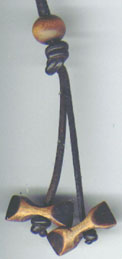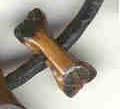|

Anyone who's been a Scouter
for a while is familiar with the story of the origin of Wood
Badge beads and their postion as recognition of completion of
volunteer training in Scouting. Each Scout Association is free
to set the standard for their awarding of the beads and traditionally
the Gilwell neckerchief or scarf and woggle (or slide). The original
beads came from two necklaces Baden Powell received from King
Dinizulu.
In the beginning, actual
beads from the necklace were presented. Later, facsimile beads
usually made of oak, were used instead of the Dinizulu beads.
The facsimile beads are
larger than the original beads as you can see from the pictures
below. Through the gracious courtesy of Mr. Peter Maryniak we've
been provided pictures of beads presented in the 1920s to Scouting
leaders in the United Kingdom upon completion of training. Thank
you Peter.
 |
Leader Trainer Wood
Badge.
(4 beads) Note the smaller
fourth bead. It is from the first Dinizulu necklace. The beads
are more squared off than beads from the second Dinizulu necklace,
|
|
 |
Assistant Leader Trainer
Wood Badge.
(3 beads) Note the smaller
third bead. It is rounder and from the second Dinizulu necklace.
The reporduction beads used today more closely follow the reounder
beads of the second necklace.
|
|
 |
Cub Leader Wood Badge.
(2 beads) presented to
a leader who has completed the Cub Leader Wood Badge. Note the
extra, round yellow bead above the lace. (The Scout Leader Woodbadge
has a green bead above the knot.) 1923
|
|
 |
Wolf Cubmasters Wood
Badge
Bear fangs were the Wood
Badge for Wolf Cub Masters Wood Badge in 1922-23.
|
|
 |
Close-up
This scan is a close-up
of an original Dinizulu bead presented to a BSA executive, but
I've lost the details of the story. This bead appears to be from
the first Dinizulu necklace.
|
|
|
|
Updated August 29, 2003 |
 |
|
![]()




